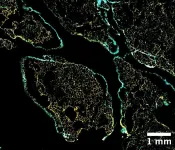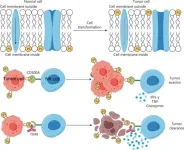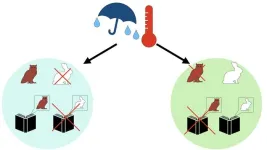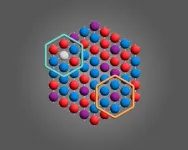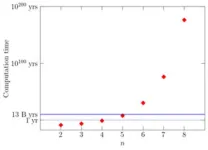(Press-News.org)
Understanding how fat tissue forms and functions is crucial for addressing obesity and related metabolic diseases. However, adipose tissue, or body fat, behaves differently based on its location in the body.
Take, for example, the omentum: a large, apron-like fatty tissue hanging from the stomach that covers organs within the peritoneum, such as the stomach and intestines. It not only stores fat but also plays roles in immune regulation and tissue regeneration.
Omental adipose tissue is associated with the “apple” body shape, which emerges when this fat depot expands significantly, increasing the risk for metabolic diseases. This expansion is not due to the formation of new fat cells, a process known as adipogenesis, but mostly through the enlargement of existing cells, a process called hypertrophy. This can lead to chronic inflammation and insulin resistance.
The limited capacity of omental fat to form new fat cells, despite calorie excess, contrasts with subcutaneous fat and remains poorly understood. Now, scientists led by Professor Bart Deplancke at EPFL have identified a population of cells in human omental adipose tissue that hinders adipogenesis. The discovery, published in Cell Metabolism, provides a new angle on the limited ability of omental fat to perform adipogenesis and has significant implications for obesity management.
The researchers used advanced single-cell RNA sequencing to analyze cells from various human fat depots, isolating different cellular subpopulations and testing their ability to turn into new fat cells. The study, supported by several medical institutions including the CHUV, involved over thirty human donors to make a detailed comparison across different fat locations.
The approach identified a population of cells present in the omental adipose tissue that may well be the key to explaining its unusual properties. These cells, termed mesothelial cells, generally line certain internal body cavities as a protective layer.
Among these mesothelial cells, some strangely transitioned closer to mesenchymal cells, which can develop into a variety of cell types including adipocytes (fat cells). This dynamic transition between cellular states may be a key mechanism through which these cells exert their influence on the adipogenic potential of the omental adipose tissue.
The study found that the mesenchymal-like properties of these cells are associated with an enhanced ability to modulate their microenvironment, providing a regulatory mechanism for limiting the expansion of adipose tissue. By switching between these two states, the cells may thus be able to influence the overall metabolic behavior of the omental fat depot and its capacity to accumulate fat without triggering metabolic complications.
“Importantly, we also uncovered at least part of the molecular mechanism by which this new omental cell population affects adipogenesis,” says Radiana Ferrero (EPFL), one the study’s lead authors. “Specifically, the cells express high levels of Insulin-like Growth Factor Binding Protein 2 [IGFBP2], a protein known to inhibit adipogenesis, and secrete this protein in the cells’ microenvironment. This in turn affects specific receptors on nearby adipose stem and progenitor cells, effectively preventing them from developing into mature fat cells.”
“The findings have deep implications for understanding and potentially managing metabolically unhealthy obesity,” explains Pernille Rainer (EPFL), another lead researcher on the study. “Knowing that omental fat has a built-in mechanism to limit fat cell formation could lead to new treatments that modulate this natural process. Furthermore, the research opens up possibilities for targeted therapies that could modulate the behavior of specific fat depots.”
Other contributors
Swiss Institute of Bioinformatics
University Hospital of Lausanne (CHUV)
University of Lausanne (UNIL)
Reference
Radiana Ferrero, Pernille Yde Rainer, Marie Rumpler, Julie Russeil, Magda Zachara, Joern Pezoldt, Guido van Mierlo, Vincent Gardeux, Wouter Saelens, Daniel Alpern, Lucie Favre, Nathalie Vionnet, Styliani Mantziari, Tobias Zingg, Nelly Pitteloud, Michel Suter, Maurice Matter, Kai-Uwe Schlaudraff, Carles Canto, and Bart Deplancke. A human omentum-specific mesothelial-like stromal population inhibits adipogenesis through IGFBP2 secretion. Cell Metabolism 09 May 2024. DOI: 10.1016/j.cmet.2024.04.017
END
A new study reveals a groundbreaking approach to immunotherapy, demonstrating that blocking the interaction between the CD300A receptor and phosphatidylserine (PS) significantly enhances the ability of human natural killer (NK) cells to lyse hematologic malignancies (HMs).
Cancer has a profound impact on human life, and immune checkpoint therapy (ICT) has made remarkable strides in cancer treatment. However, ICT faces challenges such as low overall response rates and the emergence of immune-related adverse events. To overcome these hurdles, researchers are exploring new immune checkpoints. CD300A, a type-I transmembrane protein with immunoreceptor tyrosine-based inhibitory ...
The division between liberals and conservatives on both climate-change beliefs and related policy support is long-standing. However, the results of a newly released global experiment show that despite these differences, the two camps actually align when it comes to taking certain actions to combat climate change.
The study, led by researchers at New York University, finds that when given the opportunity, liberals and conservatives take action to address climate change at roughly the same levels—and that ...
Humans have the capacity to imagine civilizations and creatures that have never existed, and our language reflects that ability. It would therefore be understandable if the stories we tell ourselves stretched beyond the bounds of local ecology. However, research has shown that many cultural artifacts and ideas are strongly affected by environmental factors.
Researchers in Japan wanted to know if the biogeography of a region could constrain motifs in animal folklore. To do this, they studied the distribution of animal trickster folklore against the distribution of the animal the folklore ...
WASHINGTON — Canadian researchers have developed a new 3D printing method called blurred tomography that can rapidly produce microlenses with commercial-level optical quality. The new method may make it easier and faster to design and fabricate a variety of optical devices.
“We purposely added optical blurring to the beams of light used for this 3D printing method to manufacture precision optical components,” said Daniel Webber from the National Research Council of Canada. “This enables production of optically smooth surfaces.”
In Optica, Optica Publishing Group’s journal for high-impact research, these researchers demonstrate the new method by using ...
(WASHINGTON, May 9, 2024) – Standard of care treatment for acute myeloid leukemia (AML) is safe and effective for adults over 80, according to a study published in Blood Neoplasia. For roughly a quarter of patients, this treatment can durably prolong survival.
AML is an aggressive and often deadly form of blood cancer that can be difficult to treat. For older adults with AML, the conventional treatment consists of a medication called venetoclax combined with a hypomethylating agent (HMA), also known as VEN-HMA. AML treatment is often intensive and can significantly suppress the immune system ...
INDIANAPOLIS -- Neighborhoods of high need are where investment in social care offers the best opportunities to improve health. Screening for social determinants of health is comparatively easy, but building the infrastructure to meet needs occurring outside the formal healthcare system is quite difficult. Few health systems have achieved more than even partial integration of social care into routine patient care.
In a case study of pioneering social care provided by Eskenazi Health, a safety net health system located in Indianapolis, ...
Australian researchers have discovered how changes in antibody levels over time can predict which children are likely to outgrow their peanut allergy.
The research, led by Murdoch Children’s Research Institute (MCRI) in Melbourne and published in Allergy, found two thirds of children with a peanut allergy remain allergic by the age of 10. But for those who did naturally outgrow their allergy, the majority achieved this by six years old.
The study was the first to use antibodies as biomarkers to identify persistent or a resolved ...
By Tom Garlinghouse for the Princeton University Department of Physics
Not all magnets are the same. When we think of magnetism, we often think of magnets that stick to a refrigerator’s door. For these types of magnets, the electronic interactions that give rise to magnetism have been understood for around a century, since the early days of quantum mechanics. But there are many different forms of magnetism in nature, and scientists are still discovering the mechanisms that drive them.
Now, physicists ...
When two animals look the same, eat the same, behave the same way, and live in similar environments, one might expect that they belong to the same species.
However, a tiny zooplankton skimming the ocean surfaces of microscopic food particles challenges this assumption. Researchers from Osaka University, University of Barcelona and the Okinawa Institute of Science and Technology (OIST) have analyzed the genome of Oikopleura dioica from the Seto Inland Sea, the Mediterranean, and the Pacific Ocean around the Okinawa Islands, and in doing so, they have raised numerous questions about speciation and the role of gene location in ...
[Highlights]
- Developed a new compilation method to generate optimal sequences to be executed on quantum computers
- The new method is based on a probabilistic approach and reduces the time to search for the optimal sequence by several orders of magnitude.
- Expected to contribute to quantum information processing at quantum nodes that support the quantum internet
[Abstract]
The National Institute of Information and Communications Technology (NICT, President: TOKUDA Hideyuki, Ph.D.), RIKEN (President: GONOKAMI Makoto, Ph.D.), Tokyo University of Science (President: Dr. ISHIKAWA Masatoshi), and the University of Tokyo (President: FUJII Teruo, Ph.D.) succeeded ...
